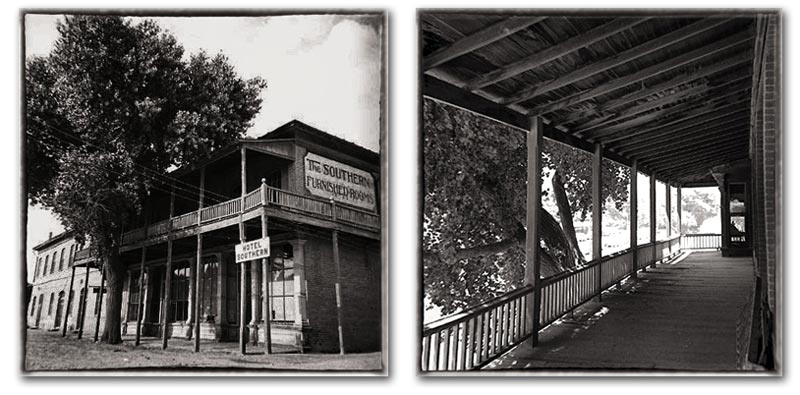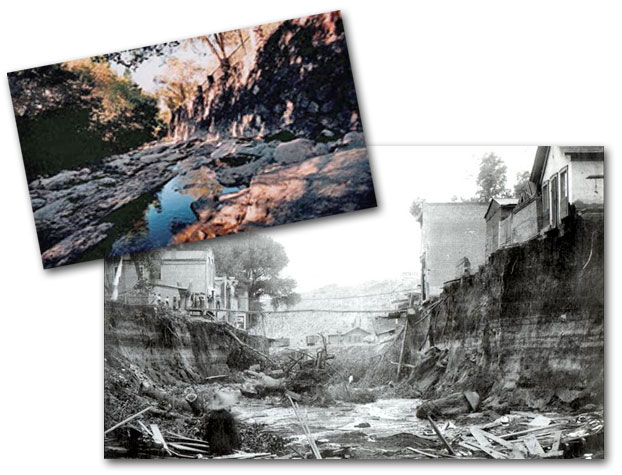An old cover takes me home to Silver City, New Mexico
During a serendipitous internet search a few years ago, my computer display filled with the image of an old envelope (a cover to us stamp collectors) postmarked 1895 in Silver City, New Mexico. Other collectors might have granted the cover only a glance, but I grew up in Silver City, so I bought it.

The cover was posted by the Azure Mining Company, which had been started by five New York businessmen in 1891. One might assume that it was a copper mine, for copper has long been the economic mainstay of the area, and copper ore is frequently veined with lovely azure colors. The Azure Mining Company, however, produced turquoise. In fact, the Silver City area produced some of the best turquoise ever found on the planet.
My family moved to southwestern New Mexico from New York State in 1949 when I was just six years old. For the first few years we lived in the tiny village of Arenas Valley, six miles east of “Silver”.
Arenas Valley was a wonderful playground for young boy, but it was Silver City and the rich history of the entire region that defined my childhood. What kid could resist the notion that with every step he might be walking almost literally in the stealthy footsteps of such notorious characters as Billy the Kid and Geronimo? That the famous Buffalo Soldiers once patrolled the surrounding hills and mountains in search of Geronimo? That Wells Fargo stage coaches laden with gold and silver had raised clouds of dust as they left town? That posses on horseback once thundered out of town, hot on the heels of desperadoes?
Today, Silver City is a popular retirement community and arts centre, but in the late 1800s mining was king. Entrepreneurs from the East focussed mainly on increasing their wealth by gouging gold, silver, copper, zinc, tungsten, and a half dozen other valuable minerals from the area now known as the Mining District.
Billy the Kid
Hundreds of Hollywood films, TV programs, comic books, novels, poems, songs, a ballet, and even computer games have portrayed Silver City’s best known resident, Billy the Kid, as every sort of character from a Western Robin Hood to a serial killer. The truth was probably somewhere in the middle.
Both Billy and Audie Murphy became my heroes when Murphy portrayed him in the 1950 technicolor movie, The Kid from Texas. I was only seven years old when I saw it, old enough to feel empathy for Billy, who is manipulated by seeks revenge for the killing of his best friend and in the end is himself murdered by Sheriff Pat Garrett.
The historical record about the young man we know as Billy the Kid is less than clear. He was apparently born Henry McCarty in New York City in 1859, to Catherine McCarty. In 1870, following the death of Henry’s father, Catherine to Indianapolis, where she met William Henry Harrison Antrim. The McCarty family moved with Antrim to Wichita, Kansas in 1870; three years later Catherine married Antrim in Santa Femoved to Wichita, Kansas and later took the name William Bonney. He and his mother and new stepfather, moved to Silver City with his mother and new step-father to Silver City as a young boy; his mother was a washerwoman at the Southern Hotel on the northeast corner at the intersection of what are now Hudson and Broadway streets.


Only one absolutely, positively authentic photograph of Billy has survived. The original ferrotype or “tintype,” on which the photograph is based, consisted of light-sensitive material on a thin metal plate. The developed image was a positive, and not reversed like an ordinary negative, which is why most reproductions of the photograph show Billy, incorrectly, as being left handed.
Billy’s criminal career apparently began at age 12 when he was arrested for his role in stealing clothing from a Chinese laundry, possibly as an accomplice to an older man, but escaped. The weekly Silver City Herald reported the story:
Henry McCarty, who was arrested Thursday and committed to jail to await the action of the grand jury, upon the charge of stealing clothes from Charley Sun and Sam Chung, celestials, sans cue, sans Joss sticks, escaped from prison yesterday through the chimney. It’s believed that Henry was simply the tool of Sombrero Jack, who done the stealing whilst Henry done the hiding. Jack has skinned out.
Following his escape, Billy pursued a brief career as a gunman. Myth portrays Billy as the slayer of 21 men, but he probably killed “just” four or possibly five men, perhaps in self defence. Billy was himself ambushed and killed — many would say he was murdered — by Sheriff Pat Garrett in 1881.
Geronimo & the Buffalo Soldiers

Geronimo, born in 1829, was a prominent leader of the Bedonkohe band of the Chiricahua Apache of Arizona, New Mexico and West Texas. After Mexican soldiers killed mother, wife, and three children in 1851, Geronimo joined revenge attacks on the Mexicans and later lead raids against Americans across southern Arizona and New Mexico and western Texas.
It was Geronimo’s misfortune to participate in the last chapters of his people’s history before they were overwhelmed by a North American Holocaust — the implacable westward migration of American society.
The American army in the form of armed cavalry arrived in the Silver City area hard on the heels of miners. Among them were units of the Buffalo Soldiers, the first peacetime all-black regiments in the regular U.S. Army. Some Buffalo Soldiers were based at Fort Bayard, 7.4 miles (12 km) east of Silver City.
The Buffalo Soldiers undertook a dual roles. An acknowledged role was that of protecting the lives and property of Americans from the “depredations” of Indians, notwithstanding the fact that it was the Indians were victims of Manifest Destiny, the belief that God obliged American citizens to stretch the boundaries of their country all the way to the Pacific Ocean, to Christianize the “heathen” aboriginals, and of course to exploit the continent’s rich resources. The unacknowledged role of the Buffalo Soldiers and the U.S. Army in general was the “pacification” of the sad remnants of aboriginal tribes, including Geronimo’s people.
The U.S. Army attempted to confine Geronimo and other Apaches (and many other tribes) to reservations, but he escaped and led a series of bloody raids — some near Silver City — that did not end until he and his warriors surrendered for the last time in 1886. As a prisoner of war in old age, Geronimo became a celebrity and appeared in fairs, but was never allowed to return to the land of his birth. He later regretted his conditional surrender, claiming that the conditions the Apaches’ surrender had been ignored. Geronimo died in 1909 from complications of pneumonia at Fort Sill, Oklahoma.
In my youth, I was probably more familiar with early Southwest history than most of my peers. That’s because my father had become the editor of weekly newspaper, the Enterprise, which had been published continuously since 1882. The walls of the Enterprise office on Bullard Street were lined with thick, brown binders containing back issues of the paper, and I often spent time browsing through them.

A Dutch Schoolatlas published in 1908 includes only one map of the United States, and no maps at all of individual states. However, but Silver City is one of only two communities shown in New Mexico (the other is Santa Fe, the capitol). At that time, Silver City was known worldwide as a modern El Dorado, the legendary South American “City of Gold” sought by Spanish Conquistadores. Today, the area’s gold and silver mines are closed. The economy of the area is still largely centred on mining, however, and new mining technologies are making “mined out” properties more attractive to investors. Although it’s still pretty much off the beaten path, tourists and retirees have again boosted the area to national prominence.
A villainous gang of thieves
In 1895, when the cover that inspired this article was was mailed, Silver City was just emerging from a long period of frontier violence. As late as 1891, a group of cutthroats called the Hall Gang terrorized ranchers with death threats and the wholesale rustling of cattle and horses. The gang, intoned the Enterprise in 1887, was “...as desperate and villainous a gang of thieves as ever infested any country.” Eventually A posse eventually brought the Hall Gang to justice after a classic chase on horseback.

The Big Ditch
One of the main geographic features of Silver City is the “Big Ditch,” an arroyo (a gulley that is normally dry, and subject to sudden flooding). When Silver City was established as a permanent settlement in 1870, however, there was no Big Ditch. Instead, a street named Main Street was laid out in a straight north-south line between Bullard and Hudson Streets. It was a disaster waiting to happen.
Not only did Main Street follow a natural drainage path from the Pinos Altos watershed and the Continental Divide, but it was developed at a time before there were restrictions on logging and grazing in what would become the Gila National Forest, or removal of brush from surrounding hillsides for firewood. By 1895, the hills around Silver City had been largely denuded. In July of that year, just five months after the Azure Mine cover was posted, a flood roared down Main Street, turning it into a deep arroyo and resulting in its abandonment for wagon traffic.
Subsequent years brought other floods. In August, 1902, a wall of water tore through what was left of Main Street, ripped the fronts off some buildings, undermined others, and left behind a gaping chasm. In the next eight years, more floods would scour the gully down to bedrock, and citizens of Silver City would begin to refer not to Main Street, most of which no longer existed, but to the “Big Ditch”.


Today, in addition to being a minor tourist attraction, the Big Ditch is a veritable storehouse of artifacts. Even a casual search of the Big Ditch in its lower, sandy stretches South of Silver City, especially after a flood, will turn up a old utensils, shards of glassware and ceramic dishes, parts of tools, and even antique marbles. My sister, Helen Francis, and her friend, Sam Perea, gathered a collection of these artifacts.
Several years ago, I noticed that a Google map of Silver City identified the Big Ditch as “Main Street”. A tourist relying on that Google map would have been sorely puzzled about the apparent “closure” of Main Street and its replacement by a deep arroyo. I contacted Google, explaining why their map was incorrect, and a few weeks later the map was corrected. A portion of Main Street north of the downtown area of Silver City wasn’t affected by the flooding, and still exists as North Main Street, a mixed-use street of homes and small businesses that stretches just 429 metres (1,406 feet), south of East 14th Street and parallel with North Hudson and North Pope Streets.
For additional information on the Azure Mine and the history of Silver City, New Mexico, see World-class turquoise from the Azure Mine and The Azure Mining Company posts a letter